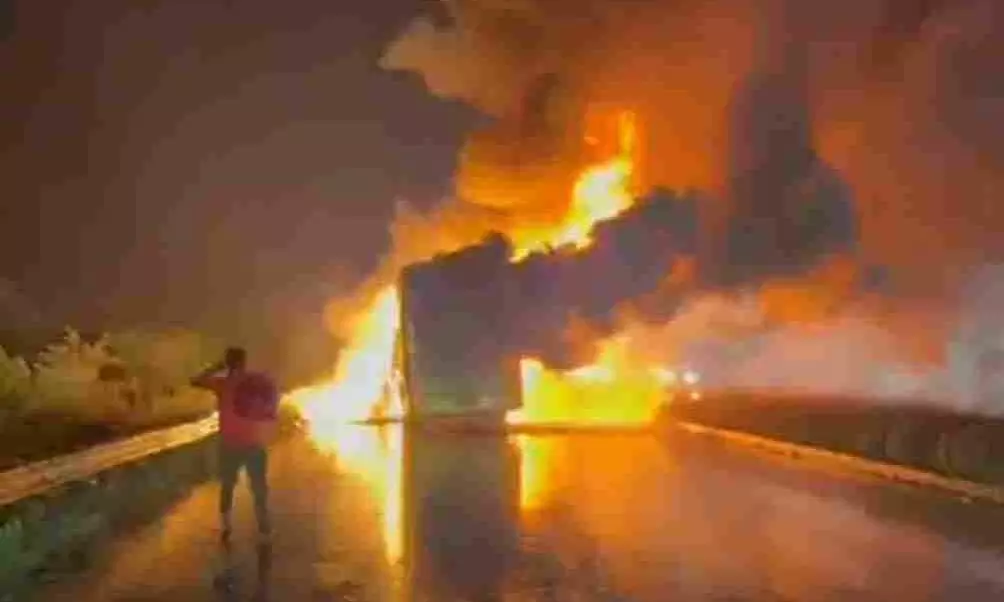
At least 20 people were killed in the accident at Kurnool early Friday.
Kurnool bus tragedy: Surge in sleeper fire accidents triggers call for nationwide ban
Flammable interiors, blocked exits, and driver fatigue fuel rise in sleeper bus accidents; lack of regulation of these 'moving coffins' are making matters worse

Private sleeper buses plying between cities and states are fast turning out to be 'moving coffins'.
The rising number of accidents, especially involving sleeper buses, is triggering widespread concern and calls to ban these vehicles are surfacing.
The recent tragedy involving a Kaveri Travels sleeper bus from Hyderabad to Bengaluru on October 24 has again brough this issue to the fore. Many experts say that lack of safety measures inside the buses, over-speeding and reckless driver behaviour, continue to cause devastating bus accidents.
Though the reasons may vary for each of these crashes, the toll is being paid with human lives.
Here are some of the recent deadly private bus accidents:
October 24, 2025: A Kaveri Travels sleeper bus left Hyderabad for Bengaluru on Thursday night. Around 3 am near Chinnatekur in Kurnool district, the bus caught fire after colliding with a bike. The blaze began in the front and claimed 19 lives.
Also read: Kurnool bus fire leaves 20 dead: People perish in sleep, fully charred
October 23, 2025: A wedding party bus caught fire near Pennapalli in Pellakur mandal of Tirupati district. Though the 35 passengers heading from Nellore to Bengaluru luckily escaped in time, the bus was completely gutted.
October 22, 2025: In Hyderabad’s Nadergul area, a Delhi Public School bus began emitting smoke after dropping off students. The alert driver acted quickly, averting a major disaster. The bus was gutted.
October 14, 2025: In a horrific accident, 20 passengers were burnt alive, 16 injured when a private AC bus in which they were travelling from Jaisalmer to Jodhpur went up in flames. The flames reportedly came from the rear end of the bus
January 19, 2025: At the accident-prone 7th mile on Tirumala Ghat Road, an RTC bus crashed into a railing. Ten pilgrims were injured. In a separate incident, a car overturned on the same road.
January 17, 2025: A super luxury bus travelling from Nellore to Jaggayyapet caught fire near Manneti Kota.
Anantapur district: Recently, a private AC bus caught fire at Thalagasipalli. All passengers escaped safely after acting quickly.
May 15, 2025: A sleeper bus heading to Delhi from Begusarai in Bihar caught fire due to a suspected short circuit, killing five passengers. Two of them were children.
November 8, 2023: At around 8.30 pm, a sleeper bus travelling from Jaipur to Delhi went up in flames on the Gurugram Expressway at Jharsa Flyover. The driver jumped out and fled.
Two passengers, a mother and her daughter, were burnt alive and the injured passengers were immediately taken to hospital.
Fuelled by flammable interiors
Flammable materials like fuel, plastic parts, rexine, and foam allow fires to spread rapidly, leading to mass casualties. Leaking pipes from the fuel tank are another common cause.
16 traffic violations
The Kaveri Travels bus that went up in flames on October 24 had 16 traffic violations registered against it in Telangana.
Between January 27 and October 9, 2024, it was booked for 16 violations. A total fine of ₹23,120 was pending against the vehicle (registration number DD 01 N 9490), which was registered in Daman Diu on May 2, 2018.
Sleeper buses turn death chambers
AC sleeper buses are increasingly becoming death traps.
Due to their flawed design, fire-related fatalities are higher in these vehicles. Because of their height and layout, it becomes extremely difficult for passengers to escape during accidents.
Also read: Mumbai: Olectra buses involved in 10 of 12 fatal accidents of wet-leased buses in 2024-25
Transport experts even refer to them as “moving coffins” and are demanding a nationwide ban. However, authorities have not taken the matter seriously.
Late-night dangers
Most long-distance bus accidents occur at night, often due to driver fatigue and drowsiness.
Lack of fire alarms or suppression systems only adds to the danger. Experts recommend installing drowsiness alert systems, but no buses in India currently have them.
A 2018 survey by the Union Road Transport Ministry revealed that 25 per cent of drivers admitted to dozing off behind the wheel. Most accidents happen between midnight and 6 am.
Sleeper buses don’t provide safe gallery spaces for passengers to move around, making escape during emergencies nearly impossible. Even emergency exits are blocked by seat arrangements, rendering them useless when needed most.
Demand for nationwide ban
China banned sleeper buses in 2012 after a series of accidents.
In contrast, these vehicles continue to operate freely in India. What’s striking is that most buses involved in major fire accidents here are sleeper buses.
Given their alarming track record, Syed Noor, president of a passenger welfare association, has urged authorities to stop them from plying.
Minister issues warning
Telangana transport minister Ponnam Prabhakar has ordered an inquiry into the recent sleeper bus tragedy on the Hyderabad-Bengaluru route.
He warned of strict action against buses that fail to comply with safety norms and announced plans to regulate private bus speeds. In light of the recent incident, he said a joint meeting with transport ministers from Telangana, Andhra Pradesh, and Karnataka would be held soon.
(This article was originally published in The Federal Andhra Pradesh)

